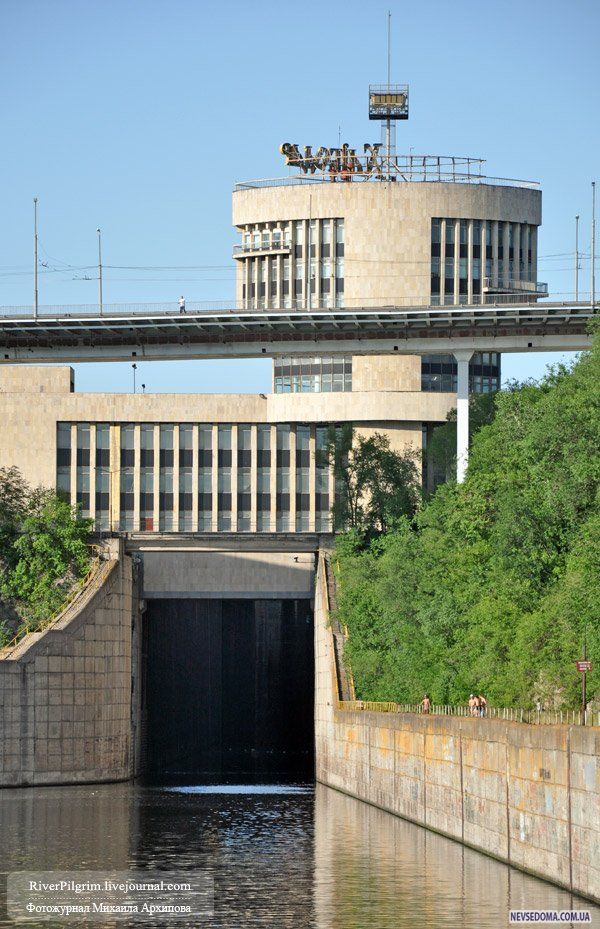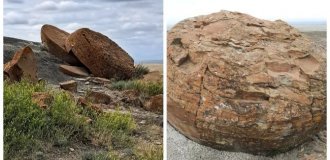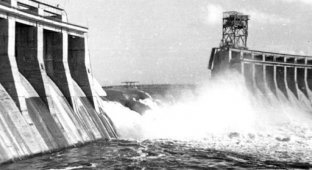DneproGES War with the Dnieper (22 photos + text)
DneproGES, Dnieper hydroelectric power station is the fifth, oldest, stage of the cascade of hydroelectric power stations on the Dnieper River. The power plant is located in the city of Zaporozhye.
"...The Dnieper, on a 100-kilometer stretch from Dnepropetrovsk to Zaporozhye, crosses a rocky ridge. For centuries, the great river rushed here between steep cliffs, forming the terrible Dnieper rapids, and only in the 20th century people managed to conquer the river. In 1927-1932 above the island In Khortytsia, the Dnieper Hydroelectric Power Station dam was built - the first hydroelectric power station of this scale in our country.The Dnieper rapids, which for centuries divided the Dnieper into two unconnected parts, disappeared forever.

Previously, the river here flowed between steep banks, therefore, despite the fact that after the construction of the dam the water level rose by 39 meters, there was no spill. But the hidden power of the river is felt when the ship approaches the Dnieper Hydroelectric Power Station from above: the depths here sometimes reach 50 meters...".
Construction of the hydroelectric power station began in 1927, the first unit was launched in 1932, and in 1939 the design capacity of 560 MW was achieved. At that time it was the largest hydroelectric power station in the USSR.

During the Great Patriotic War, the Dnieper Hydroelectric Power Station dam was destroyed and the turbine room equipment was destroyed.


"...In August 1941, German troops, having occupied the right bank of the Dnieper and the island of Khortitsa, rushed to Zaporozhye, where factories were being evacuated at that time. In order to prevent the enemy from entering the city, the Soviet command decided on August 18 to blow up the roadway of the dam at the right banks and a bridge across the New Dnieper. A huge wave demolished the German crossings. Unfortunately, in the flood zone of the island of Khortitsa there were a significant number of Soviet soldiers who did not have time to cross to the left bank, they were also carried away by the water....".

In preparation for the retreat from Zaporozhye, the Germans mined the dam and hydroelectric power station. Thanks to scouts led by Nikolai Kuruzov, the mutilated dam was saved, but the hydroelectric power station, the roadway of the dam and the outer bridge were blown up on December 29, 1943. The restoration of the Dnieper Hydroelectric Station began with the laying of suspension bridges between the destroyed piers.
During 1944-1945, the bridge over the lock was restored. Summer 1945 The antechamber bridge was restored to its pre-war form. Already March 3, 1947 The hydroelectric power plant produced the first industrial current. June 26, 1950 The last unit of the revived Dnieper Hydroelectric Power Station was put into operation.
2. Old machine building of the hydroelectric power station.

3. Dam.

At the end of the 1960s, the issue of increasing the capacity of the Dnieper hydroelectric power station, the capacity of its lock and the roadway of the dam became on the agenda. The reconstruction of the Dnieper hydroelectric station began, which took place from 1969 to 1980. During the reconstruction, another turbine room was built near the left bank, in which 8 units with a capacity of 103.5 thousand kW each were installed, a single-chamber lock capable of passing river-sea vessels. The roadway of the dam was reconstructed and significantly expanded, which was connected to the left bank by an overpass bridge, and to the right bank by a new outer bridge.
4. New machine building.

5. Cameras of the old three-chamber airlock. After the construction of a new sluice chamber (mine type) as part of the second stage of the DneproHPP, they were taken out of operation. They are currently undergoing reconstruction and may soon be put into operation again. With the decline in the number of cargo transportation along the Dnieper, it would be more profitable to pass ships here than in the new chamber.

General view of the dam, turbine rooms and locks.


6. Gateway. We depart from the Zaporozhye pier and go up to the lock.

7. The approach channel to the old locks goes to the left, our path goes around the bend, to the right, into the new chamber.

8. Highway and control room of the waterworks. Previously, ships had to overcome a 39-meter difference in levels in the adjacent three-chamber lock, but during the reconstruction of the waterworks in the 80s, a second line with a single-chamber mine lock was installed.








16. Towers of the old gateway.























